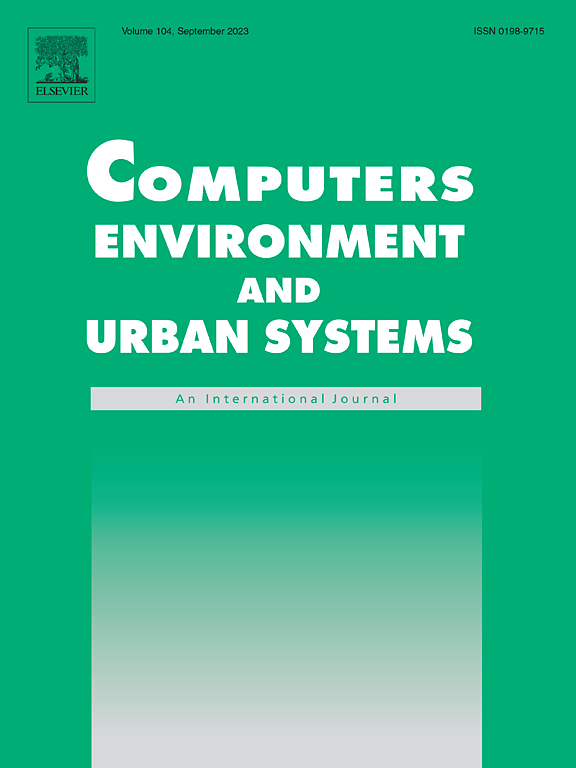Unraveling nonlinear and spatial non-stationary effects of urban form on surface urban heat islands using explainable spatial machine learning
IF 8.3
1区 地球科学
Q1 ENVIRONMENTAL STUDIES
Computers Environment and Urban Systems
Pub Date : 2024-10-04
DOI:10.1016/j.compenvurbsys.2024.102200
引用次数: 0
Abstract
Under global warming, surface urban heat islands (SUHI) threaten human health and urban ecosystems. However, scant research focused on exploring the complex associations between urban form factors and SUHI at the county scale, compared with rich studies at the city scale. Therefore, this study simultaneously examined the nonlinear and spatial non-stationary association between SUHI and urban form factors (e.g., landscape structure, built environment, and industrial pattern) across 2321 Chinese counties. An explainable spatial machine learning method, combining the Geographically Weighted Regression, Random Forest, and Shapley Additive Explanation model, was employed to deal with nonlinearity, spatial non-stationary, and interpretability of modeling. The results indicate the remarkable spatial disparities in the relationship between urban form factors and SUHI. Landscape structure contributes the most in southern counties, while the built environment is more important in northeastern counties. The impact of building density and building height increases with the county size and becomes the main driver of urban heat in mega counties. Most urban form factors exhibit nonlinear impacts on SUHI. For example, urban contiguity significantly affects SUHI beyond a threshold of 0.93, while building density does so at 0.17. By comparison, the influence of shape complexity remains stable above a value of 7. Factors such as industrial density and diversity have a varied influence on SUHI between daytime and nighttime. The results of local explanations and nonlinear effects provide targeted regional mitigation strategies for urban heat.
利用可解释空间机器学习揭示城市形态对地表城市热岛的非线性和空间非稳态影响
在全球变暖的情况下,地表城市热岛(SUHI)威胁着人类健康和城市生态系统。然而,与城市尺度的丰富研究相比,很少有研究关注县级城市形态因素与 SUHI 之间的复杂关联。因此,本研究同时考察了中国 2321 个县的 SUHI 与城市形态因子(如景观结构、建筑环境和产业模式)之间的非线性和空间非平稳关联。研究采用了可解释的空间机器学习方法,结合地理加权回归、随机森林和 Shapley Additive Explanation 模型来处理非线性、空间非平稳性和建模的可解释性问题。结果表明,城市形态因素与 SUHI 之间的关系存在明显的空间差异。景观结构对南部县的影响最大,而建筑环境对东北部县的影响更大。建筑密度和建筑高度的影响随着县域面积的增加而增大,在特大型县域成为城市热量的主要驱动因素。大多数城市形态因素对 SUHI 都有非线性影响。例如,城市毗连度对 SUHI 的影响超过 0.93 的临界值,而建筑密度对 SUHI 的影响为 0.17。工业密度和多样性等因素在白天和夜间对 SUHI 的影响各不相同。局部解释和非线性效应的结果为城市热量提供了有针对性的区域缓解策略。
本文章由计算机程序翻译,如有差异,请以英文原文为准。
求助全文
约1分钟内获得全文
求助全文
来源期刊

Computers Environment and Urban Systems
Multiple-
CiteScore
13.30
自引率
7.40%
发文量
111
审稿时长
32 days
期刊介绍:
Computers, Environment and Urban Systemsis an interdisciplinary journal publishing cutting-edge and innovative computer-based research on environmental and urban systems, that privileges the geospatial perspective. The journal welcomes original high quality scholarship of a theoretical, applied or technological nature, and provides a stimulating presentation of perspectives, research developments, overviews of important new technologies and uses of major computational, information-based, and visualization innovations. Applied and theoretical contributions demonstrate the scope of computer-based analysis fostering a better understanding of environmental and urban systems, their spatial scope and their dynamics.
 求助内容:
求助内容: 应助结果提醒方式:
应助结果提醒方式:


